Low-Cost Synthesis of High Performance Polyurethanes
Background
Polyurethane (PU) materials, including elastomers, flexible/rigid foams, films, coatings, fibers, and thermoplastics are of growing interest in the field of green chemistry. In 2017, approximately 5.8 billion pounds of PU materials were consumed in various end-use markets such as building and construction, furniture, and bedding with an economic output reaching $296.8 billion in the US. Currently, there is yet to be an economically viable model for a lignocellulosic biorefinery.
Brief Description
Professor Charles Cai from the University of California, Riverside has developed a method to produce a high-performance, renewable polyurethane material made from biomass lignin for use as an adhesive, resin, coating, or plastic. In this method, diols were introduced to realize faster and complete dissolution of technical lignins in volatile organic solvents, which improve lignin miscibility with other components and its dispersion in the PU materials. This technology is advantageous because it improves the economic viability of lignocellulosic biorefinery, can replace petroleum-based polyols in commercial polyurethanes products to reduce carbon footprint, and, as a natural UV-block, lignin reduces the UV aging of PU materials.

Fig 1: The UCR method to produce polyurethane material from biomass lignin.
Application
- To produce a high-performance, renewable polyurethane material made from biomass lignin for use as an adhesive, resin, coating, or plastic.
Patent Status
| Country | Type | Number | Dated | Case |
| United States Of America | Published Application | 2023036574 | 11/16/2023 | 2022-895 |
Related Materials
Contact
- Grace Yee
- grace.yee@ucr.edu
- tel: View Phone Number.
Other Information
Keywords
bioplastic, resin, coating, polyurethane, adhesive, lignin, biomass, bioproduct
